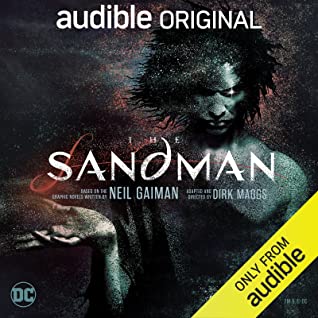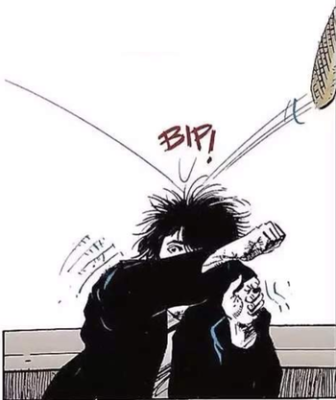
Neil Gaiman refuses to call this an audiobook. And look, he’s not half wrong, it’s more of an audio play than anything else. But for the purpose of reviews, I’m going to treat this as a book. And no matter how we characterise it, this is a bloody marvellous piece of work, and one of the most pleasantly surprising things to come out of 2020.
The premise is a bit daunting when you think about it: a comic book is a very visual medium that can afford to be frugal with the text. An audiobook is the very opposite: as a purely aural medium, sound direction is king. To convert one from the other takes a good deal of care and forethought.
And I have to say, Audible Studios has done a mostly excellent job here. The art from across the multiple volumes of The Sandman can be quite intricate and almost ethereal at times; the main character, Morpheus, is the Lord of Dreams, and the surreal is the purview of dreams. No matter how they approached it, something was going to be lost in the translation to audio. So Audible has attempted to rectify this anticipated loss in three ways: by expanding Neil Gaiman’s narration, employing some impressive musical and vocal direction, and recruiting some very impressive vocal talent.
And for the most part, it works. This adaption covers the first three volumes of the original and I have to say the main deficiencies are found first one: Preludes and Nocturnes. Unfortunately, this is right at the start of the adaption, so I beg anyone who gives this a try to have patience. The main issue here is in the structure of the narrative: we’re quickly skipping through the decades that cover Morpheus’ confinement. And in order to convey this, they have to lean on Neil Gaiman’s narration quite extensively. Now I find no fault in Gaiman as a narrator—either as the reader or the one penning the expansions to his original work—but this set of rapid progressions between scenarios and dates doesn’t give anyone much to work with.
But elsewhere in the adaption? This narration works beautifully. Neil was the one who wrote the original story, and he’s more than capable of describing the illustrations others drew for his work. And once the narrative takes on a more natural flow, we become less dependant on the narration to provide us with structure and we instead start relying on the strengths of the voice and musical direction.
This is where I have to bring up the casting—it’s just incredible. James McAvoy makes for a marvellous Morpheus. While he often has to do a lot of heavy lifting on his own early on, he does bounce rather well off both Michael Sheen as Lucifer and Shey Greyson as Rose Walker. While fans of Gaiman’s previous works might be having a little giggle over Sheen’s casting, Shey Greyson is a relative unknown and I hope she gets more recognition after this. Riz Ahmed’s turn as The Corinthian should also be noted, for how surprisingly creepy it was. And while Kat Dennings is an otherwise a very good fit for Death, it was amusing when she and McAvoy shared scenes, because I did have trouble connecting them as siblings! The two of them are quite disparate—but I guess The Endless are not like us.
What was also interesting to consider was how differently certain scenes came across in the audio production compared to the original. The main standouts for me were Jed’s plight and John Dee’s actions with the diner patrons. With Jed, it was the fact that no matter how anyone illustrates the kind of nightmare scenario he found himself in, nothing could convey the distress of a child more than actually hearing them cry themselves. That one hit me hard.
The diner was worse, though. In the graphic novel, the changing colour palette and heavy-handed shadowing helped convey just how grim things got as everyone spiralled out of control. But in the audio adaption, everything is more visceral. The combination of vocal direction and sound effects here makes the whole listening experience quite …uncomfortable. And if the over-reliance on the narration was a hindrance in the first part of the adaption, it’s absolutely doing its job correctly here. Pairing Gaiman’s calm recital of what happens at Hour 17, Hour 18 and Hour 19 with the increasingly deranged activities in the diner results in a sort of synergy of horror. I had to take a break after dealing with John Dee. And I thought I had a pretty iron constitution.
But it’s not all nightmares and horrors—there’s unexpected humour to be found in the audio adaption as well. A lot of this was, surprisingly, from Morpheus himself. Whether it’s his frantic search for sustenance after his confinement, or his reaction to Rose Walker telling him flying’s better than sex, McAvoy’s efforts to convey a bemused Lord of Dreams made me giggle more than once.
Unfortunately though, one of the funniest panels from the original just doesn’t translate well in the adaption. Oh well, Death has to cement her awesome nature in other ways.

Would I recommend the audio version of The Sandman to a new-comer to the series? It’s kind of hard to say. My main hesitation is with the very first part of the first volume, Preludes and Nocturnes. It’s slow in the original, but virtually treacle-like in its viscosity in the audio adaption. So I’m not sure. But I’m confident that most fans of the graphic novel will appreciate this new production.
And now I’m sitting here buzzing in excitement for the next instalment. There hasn’t been much news yet on release dates, but I hope we’re not waiting too long.
